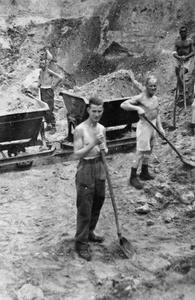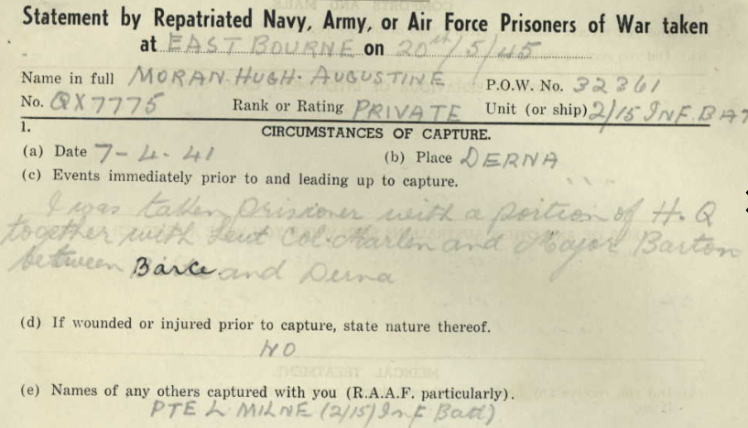After Pte Hugh Moran enlisted in 1940 he was sent first to Darwin then north Africa where he was captured and taken as a Prisoner of War to Italy from 1941 to 1943. You can read about his experience in Part I.

As the Italians signed the Armistice of Cassibile in September 1943, the Germans took over the prisoners of war and promptly relocated them north. There is a website, drawn on the NZ Official History of WWII, which reveals the reality of this transfer and what it means to POWs like Hugh[i]:
From those camps that were taken over by German troops in September 1943, all except the few who succeeded in hiding were marched to the nearest railway station. The Germans took what precautions they could to prevent escapes-a strong guard along the route, threats before setting out of the dire consequences that would follow any attempted breaks, even a demonstration with a flame-thrower at Campo PG 57.
Most of the trains went north via Verona, through the Brenner Pass to Innsbruck, though a few took the more easterly Tarvisio Pass to Villach…They were almost entirely made up of cattle-trucks and closed goods-wagons with a very few third-class carriages… Into these trucks the prisoners were packed, as many as fifty in each…The sliding doors were closed and bolted, and prisoners were left for the journey with at most two small openings in the sides of the truck for air and light, no provision for latrines, and only such food and water as they had been able to carry with them….There were occasional halts on the journey north, often not long enough for every truckload to be allowed out. On the longer journeys there were considerable halts at stations and sometimes meals from the German Red Cross.[ii]

Those from Campo 57 were the first large party from Italy to reach Stalag XVIIIC at Markt Pongau in Austria, a transit camp …roughly 25 miles south of Salzburg, the camp was very dirty and the barracks infested with vermin… For the first time they tasted the typical German stalag fare – vegetable soup and ‘black’ bread, boiled potatoes and mint tea. After a fortnight or so most went north to Stalag VIIIA at Görlitz in Saxony.
Hugh was among those transferred to Stalag VIIIA on 24 September 1943 thence to Stalag VIIIB on 2 November 1943 and in June 1944 to Stalag 344 (my understanding is the latter two were essentially the same). These prisons were in Lamsdorf in then-Upper Silesia, and now called Łambinowice in Poland.[iii]
This huge camp (VIIIB/Lamsdorf) which had started to show improvement since the appointment of a new German commandant, now became still larger through the sudden influx from Italy and numbered well over 30,000, 10,000 of them in the stalag itself … Those who had come from Italy, more especially those from Campo PG 57, wondered at the comparative lack of discipline in this camp and at the activities that could go on inside it unknown to the enemy… Sooner or later the newcomers, who had all been graded by German doctors according to the type of labour they were medically fit for left for coal mines or other places of work in Silesia.
It is Hugh’s German Prisoner of War record, included with his AIF personnel file, that reveals more details about his experience. He has plainly completed the basic details, as the rest is written in German. The photograph included shows the impact of the preceding years as he is plainly gaunt and has acquired the typical McSherry baldness (inherited through his mother). It also tells us he blond (really?) and 177cms tall (70 inches), approximately the same height as me – which makes him short for a male with McSherry genes.


However, in his debriefing on return to the United Kingdom in 1944, Hugh describes the Stalag/prison rations, accommodation, bathing and hygiene as “bad” and the recreational facilities as “poor”. While he had not been required to work while in Italy at Campo 57, Hugh states that in Germany he did hard manual labour, pick and shovel work, for 12-14 hours a day. All of which no doubt contributed to his gaunt frame in the photograph taken in Germany, or exacerbated it.
His troubles were far from over, however. As the war ground towards its conclusion, and the arrival of Russian troops became imminent, the German forces made the decision to move their prisoners west. And so started what was to become known as the Long March[iv], The Black March, The Bread March or the Lamsdorf Death March but most survivors just called it “The March”. In the depths of winter under freezing conditions, with minimal food, the men walked hundreds of kilometres, between January and March 1945[v] with the Lamsdorf men heading north via Dresden. (You can see a map here of POW movements). It was an exhausting, hazardous and debilitating experience for the men, drawing on reserves of strength both physical and mental.

With the surrender of Germany, on 4 May 1945 RAF Bomber Command implemented Operation Exodus, and the first prisoners of war were repatriated by air in aircraft. Bomber Command flew 2,900 sorties over the next 23 days, carrying 72,500 prisoners of war.[vi]

Private Hugh Augustine Moran was one of the prisoners recovered by Bomber Command, and for me it’s interesting to ponder whether a friend of ours, Don Curnow, was part of this relief effort. Hugh’s personnel file records that on 19 May 1945, he was deplaned UK as recovered PW (Prisoner of War) M/I and taken on holding strength at 1AIF Transit Camp. This is presumably where his debriefing took place. In this statement, he records that he had been captured on 7 April 1941, with a portion of HQ and including Lt Col Marlan and Major Barton as well as Private L Milne (2/15Bn).


After capture, Hugh had been held at Campo 57 from 15 May 1941 to 15 September 1943 then Stalag VIIIA from September to November 1943 before transfer to Stalag VIIIB/344 from May to November 1944. There are a number of photos of the camp on the Imperial War Museum site, but many are copyrighted. While in Germany he was given “reasonable” treatment for stomach pains and bronchitis. He states he had not received Red Cross parcels or mail during his time there. Had his parcels or mail been blocked or did his family not know where he was?

On 7 June 1945, Hugh once again had a stint AWOL…for a whole three hours. Who could blame him after being confined for four years? Apparently the Army didn’t feel the same as he was docked a total of 12 days pay…I suppose they didn’t want these men to get delusions of independence, or insubordination. It’s ironic that he told the Germans his former occupation was “timekeeper” which is pretty odd for someone who seemed to miss returning to barracks by mere hours on most occasions.
On 19 June Hugh was repatriated to Australia on the ship “J12” and on 24 August, he was taken on strength in Queensland. Apparently while in Sydney he was taken to the Camp Hospital with scabies. I imagine it was quite some time before his health returned to normal, if ever. He was discharged from the Army on 13 September 1945, leaving him to continue life as a civilian. I can’t help wondering if he wished he’d joined the railway, a reserved occupation, and one held by most of the McSherry men over some generations.

Hugh died on 8 February 1995, when he was 88 years old, which is amazing considering what he’d gone through. He is buried in the Martyn St Cemetery in Cairns.
It was a revelation to me to unearth this story of my first cousin once removed, Hugh Augustine McSherry[vii]. I hope this post serves as a memorial to his contribution to Australia’s military history.
You can read other posts about Pte Hugh Moran here and here.
LEST WE FORGET
Thanks to my cousin Bev for sending this photo of Hughie in later life at his cousin’s birthday. Isn’t it lovely to see him looking happy and healthy? If I’m not mistaken, he’s wearing his RSL pin. Thanks Bev.

Previous Anzac Day posts are:
2016 and 2012: Villers-Brettoneux and James Paterson
2015: A Gallipoli Everyman: Victor Joseph Sanders
2014: Postcards to the Front 1917
2013: Valiant Indigenous Anzacs
2011: Honouring the Australian-born Diggers with German ancestry
Wealth for Toil on the Railway includes the story of my grandfather’s war service.
[i] http://nzetc.victoria.ac.nz/tm/scholarly/tei-GreLong-t1-body-d8.html extract from the NZ Official History
[ii] Ibid
[iii] http://www.lamsdorf.com/history.html
[iv] http://nzetc.victoria.ac.nz/tm/scholarly/tei-GreLong-t1-body-d9.html
[v] http://www.lamsdorf.com/the-long-march.html. DO READ THIS IF POSSIBLE.
[vi] ibid
[vii] B503, Q2334 Prisoner of War Record and B883 QX7775. http://naa.gov.au
What a wonderful record you have unearthed! It is hard to imagine what he went through in captivity.
LikeLiked by 2 people
Thanks Linda…it must have been a roller coaster of emotions and experiences, and yet he lived to such a good age.
LikeLiked by 1 person
Just don’t know what to say as what some people went through was so horrific that my mind sanitised and blocked out so much to cope with the horror. This post is a wonderful memorial to Hugh McSherry.
LikeLiked by 2 people
Thanks Fran. The long march, in particular, would have been horrifying but four years in prison camps would “do your head in”.
LikeLiked by 2 people
A fantastic summary of your exhaustive research and a wonderful memorial, as well as being a gripping read.
LikeLiked by 1 person
Thank you Kirrily.
LikeLiked by 1 person
Another awesome chapter…fantastic read Pauleen. Congrats!
LikeLiked by 1 person
Thanks Fiona!
LikeLike
How on earth did he live so long after all he went through? An amazing man with a great strength of character… thank you for sharing his story.
LikeLike
It’s all in the genes I suspect Chris…and somehow it seems those who did survive often seemed to live to a ripe old age.
LikeLiked by 1 person
I love reading stories of old soldiers. Thanks for another one! I suppose those years in Europe changed him forever. I wonder how his life was after? I wonder how he remembered the war, and how he talked about it. How it made him what he was for the remainder of his life. We can only imagine…
LikeLike
Thanks for visiting David. So many things we will never know about these old soldiers….we can indeed only imagine. I was thrilled that my cousin shared his photo in his old age…he looked happy and relaxed….made me feel content.
LikeLike